February 24th, 2014
Shyam
Counting on the Feds alone to fund Metro ignores a long tradition of local jurisdiction funding support – and a ticking clock.

Image borrowed from eRationalmarketing.com. Click for original.
As the region grapples with mounting infrastructure needs (DC, MD and VA) regional leaders are experiencing a bit of sticker shock. That’s because this region has been enjoying the benefits of massive infrastructure capacity increases in transportation, water/sewer, and power that were built in the 1970s and were designed to keep up with growth for half a century.
Those fifty years have almost run out, as has our ability to grow into the capacity built by the previous generation of leaders. And if this region is going to continue its growth trajectory into the middle of this century, we’re going to need to invest in the supporting infrastructure capacities – including funding transit capacity increases via Metro 2025.
Some have argued that funding Metro improvements is primarily responsibility of the Federal government, or at least that the Federal government should lead this effort. That line of argument syncs up neither with the past, present or future – in reality, local jurisdictions have always played a significant role in funding Metro. Let’s lay out the facts about role of local jurisdictions in funding Metro.
- Fact: From 1969 to 1999, of the approximately $10.0 billion spent to construct the original 103-mile system, about $3.8 billion came from local jurisdictions, who always played a large role in the infrastructure investment:
- Fact: System enhancements, such as the Largo Extension and NoMA station, were largely paid for with local money. The Largo extension was paid for with 40% local money (DOC), and the NoMA station was funded with a combination of public and private local monies (PDF) that comprised more than 75% of the capital cost.
- Fact: As WMATA’s Capital Improvement Program (CIP) transitioned from a system expansion focus to more infrastructure renewal, the reliance on federal funding declined. Just look at the graphic below.
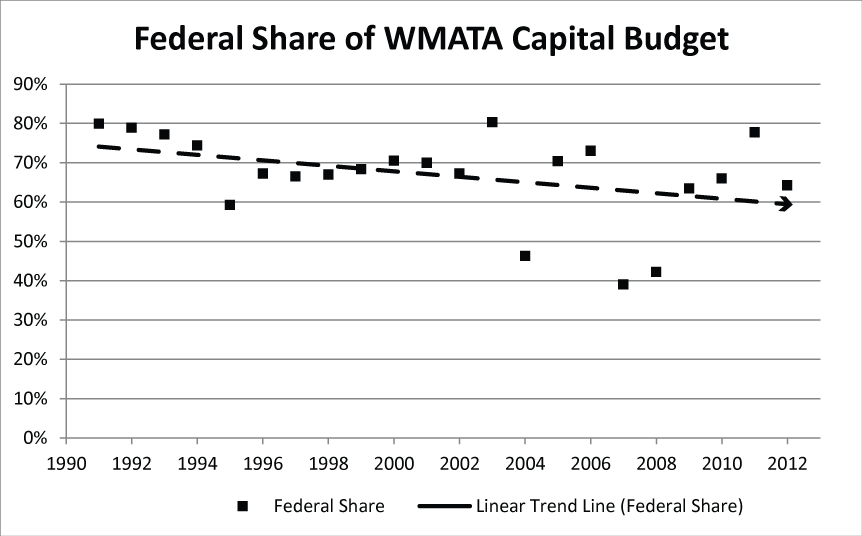
Federal share of WMATA capital budget, 1991 to 2012. Source, NTD.
- Fact: While the 2008 Passenger Rail and Infrastructure Investment Act (PRIIA) authorizes $1.5 billion over ten years to support WMATA’s CIP, Congress was clear in mandating that this funding is contingent upon matching contributions from the region’s governments. In other words, without local jurisdiction funding commitments, monies from the Federal government would not materialize.
- Fact: Among the
two three that does not have a dedicated regional funding source. This despite being the second busiest subway and sixth busiest bus operator in the entire nation.
Those that monitor the Federal government know well that funding sources for major capital projects are in decline, and there are no guarantees to the legislative process. Just take a look at this graphic, from the U.S. Department of Transportation’s Highway Trust Fund Ticker. Read more…
The Transportation Planning Board (TPB) estimates that without funding commitments from Congress, the District of Columbia, Maryland, and Virginia for Metro’s ongoing maintenance and core capacity improvements, as many as 32,000 future daily transit riders would be pushed onto the roadways instead.
In a recent report, the TPB cites that under the current funding trajectory, Metrorail riders will face significant crowding and experience less service reliability in the future. Critics often cite low forecasts of future Metrorail ridership from the TPB as a reason to avoid committing robust levels of funding for transit. What they don’t tell you is that the ridership numbers emerging from the travel demand model are manually “capped” so that there is no ridership growth beyond 2020 – the year beyond which current levels of maintenance funding levels expires. In other words, because regional leaders have not committed to funding transit, those that forecast travel demand have decided to stop forecasting increases in transit usage. Were it not for this artificial “cap”, travel demand forecasts would show much higher numbers of future transit use. We all know that such a “cap” ignores the last 10-15 years of increasing transit usage region-wide (performance analysis of the CLRP 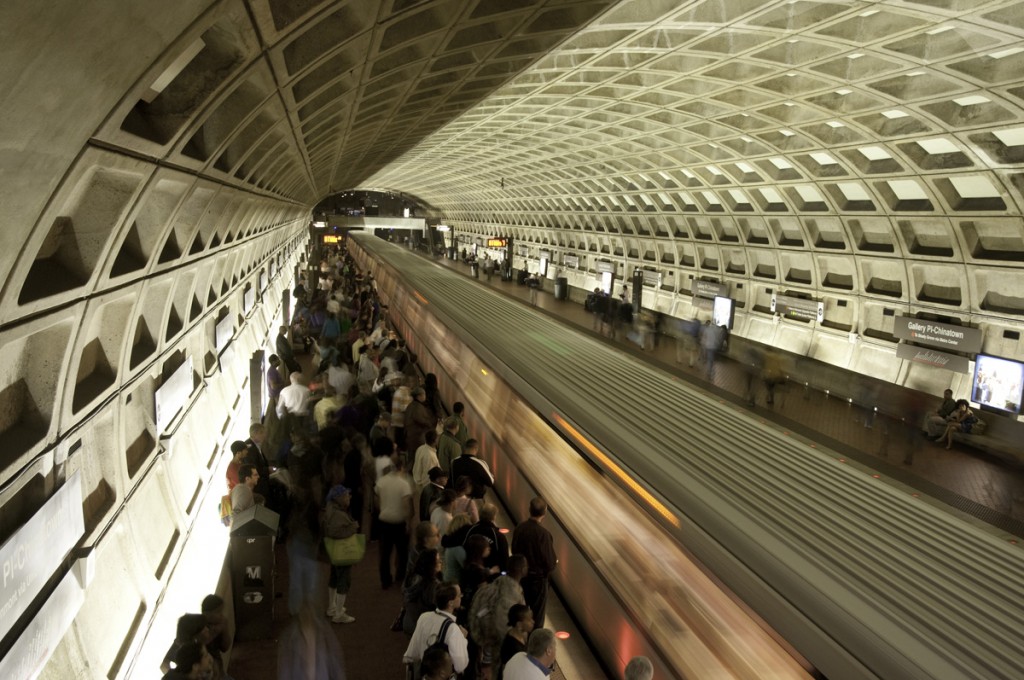 )
)
Metro’s strategic plan, known as Momentum, proposes a number of core capacity improvements to handle more riders, and offers a plan of initiatives necessary to remove the so-called “transit constraint” placed on the system in 2000. Metro 2025, one of the main components of Momentum, includes:
Read more…
Without Metro 2025, the region might give up more jobs than the current size of 80 of the nation’s 100 largest downtowns.
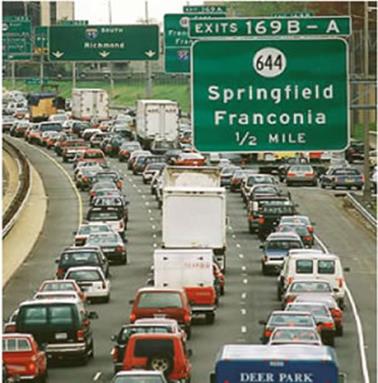
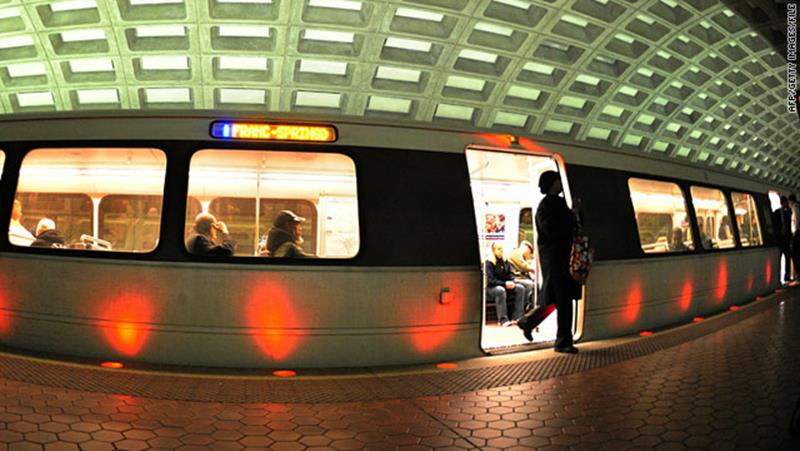
One way to alleviate congestion – limit transit funding and stymie job growth!
The Washington, D.C. region earned in 2012 the unfortunate honor of being named the #1 region in the nation – for congestion. For the workers in this region this comes as no surprise, as seemingly endless “volume delays” litter our evening traffic reports, commuters spend more than a full week and a half sitting in traffic each year, and even the public transit network – primarily Metrorail – is so crowded that commuters often have to wait for multiple trains just to squeeze onto the system. And unless proposed transportation investments keep up with projected household and job growth – MWCOG projects that the region will add 1.6 million jobs by 2040 – these commutes are only going to become more painful.
We all know that the high price of congestion is in the billions of dollars per year, a figure that would be even higher but not for transit’s impact has in reducing the region’s congestion by 10 to 15 percent, saving commuters time and money stuck in traffic, and preventing the need to build hundreds of thousands of new parking spaces and 1,000 additional lane miles of roads.
But that price pales in comparison to what may be if we don’t act now to make meaningful improvements to the regions congestion-reducing transportation infrastructure, especially in programs like Metro 2025. Turns out that we now know that when regions exceed 35 to 37 hours of delay per commuter per year – about four and a half minutes per one way free flow trip – regional job growth begins to slow. That means that expectations of continued economic growth in the region are a lot less rosy when we consider that we currently run about 72 hours of delay per commuter per year – and rising. And before you dismiss this as planning theory, remember that Hewlett Packard showed Atlanta and the nation in 1998 that congestion’s negative impact on employment growth can be economic fact. Read more…
Priority treatments speed up buses, which saves everyone time and money, uses street space most efficiently, and attracts development.
Bus priority projects, such as those begun through the regional TIGER grant and included in the Metrobus Priority Corridor Network Plan, will improve travel times, increase service reliability, and attract thousand of new riders once fully implemented.
But let’s step back for a moment. Why are these improvements needed?
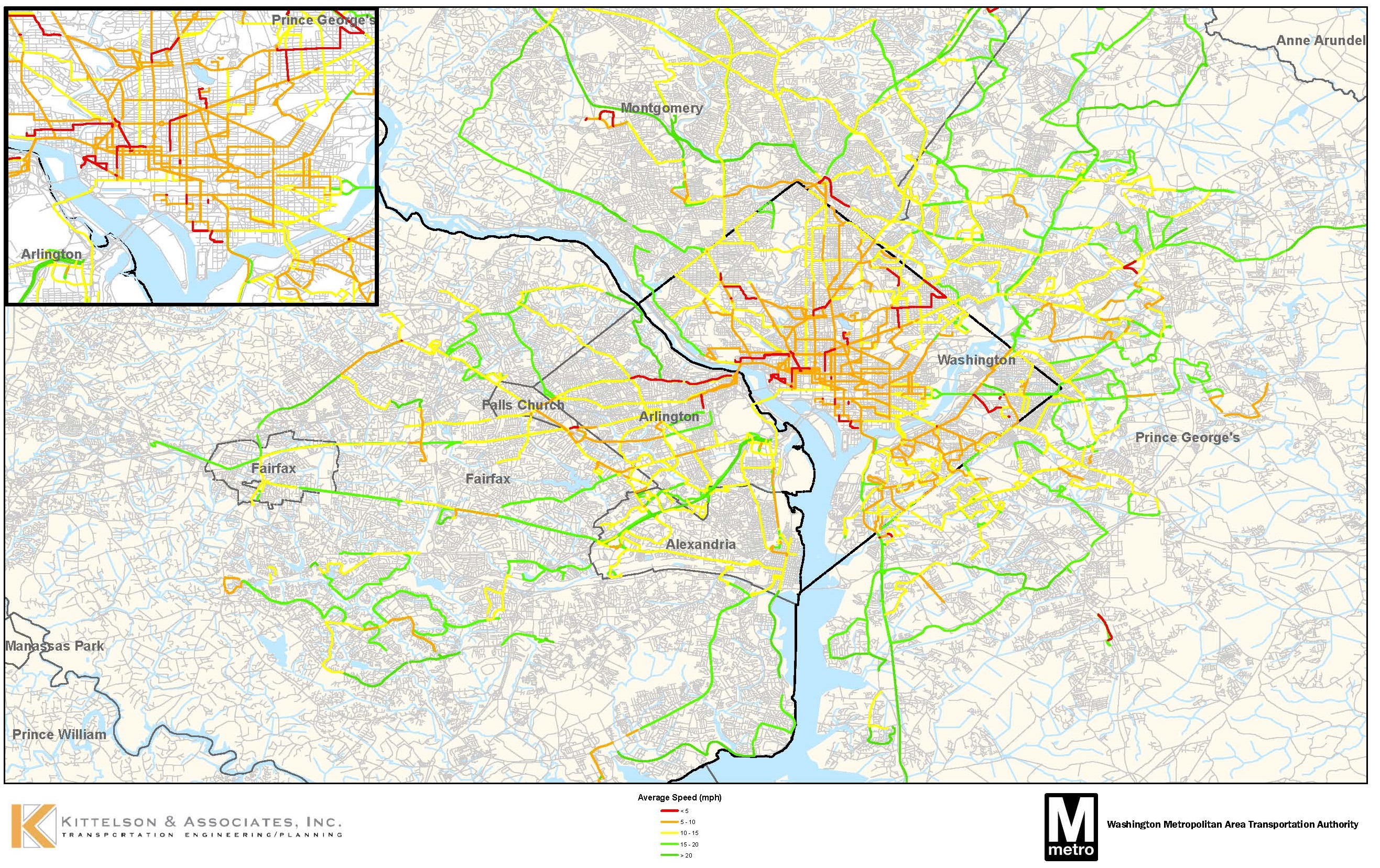
Average AM Rush Hour Bus Speeds (Nov. 2009)
Read more…
During the morning rush hour, Metrobus carries 50% of all of the people traveling on 16th Street NW towards downtown DC, despite using just 3% of the vehicles. However, it still gets stuck in traffic.
It will come as no surprise to regular riders of the Metrobus S1,2,4 (PDF), or MetroExtra S9 (PDF), but ridership has grown tremendously in recent years on 16th Street, from just over 16,000 riders per weekday in 2008 to about 20,500 this year. To keep pace, Metro has added lots of new service, most notably the S9 limited stop service in 2009.
In fact, Metro has added so much rush hour service on lower 16th Street that buses headed towards downtown DC now operate more frequently than any transit service in the region, including Metrorail, with buses arriving an average of nearly every 90 seconds.
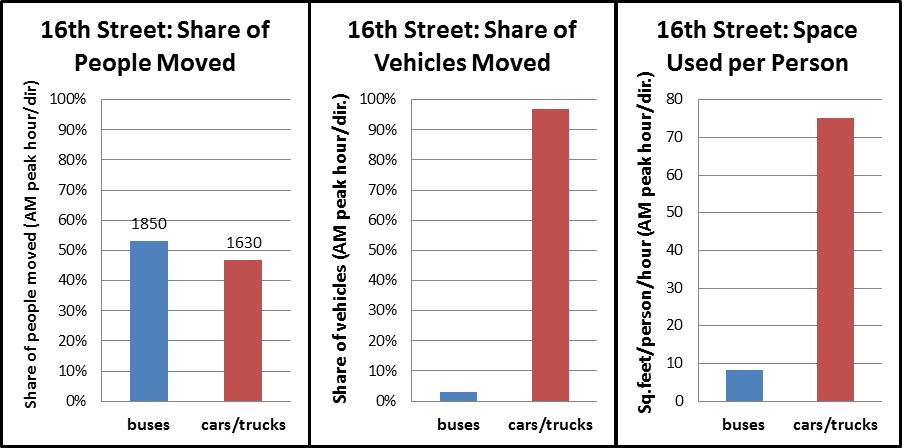
Read more…
Federal TIGER Grant-funded bus priority projects are moving forward, setting the stage for the Metro 2025 Priority Corridor Network.
In 2010, a local consortium of agencies including WMATA was awarded a $59-million Transportation Investment Generating Economic Recovery (TIGER) Grant for bus priority in the Washington Region. The National Capital Region Transportation Planning Board (TPB) is the primary project manager and recipient of the of the grant, and TPB staff provided a briefing of the status of the implementation of the TIGER projects (PDF). This post provides a summary of the projects in which Metro is engaged, as well as a history of the TIGER grant award to the region.
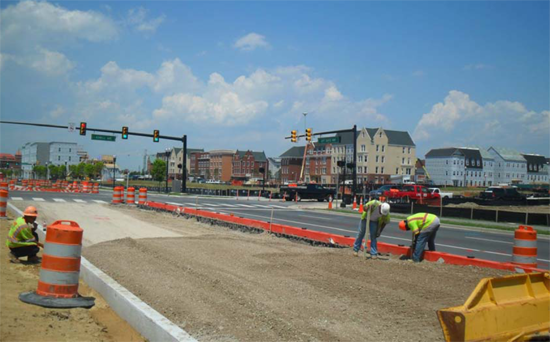
Construction of the Crystal City Potomac Yard Transitway, from May 30, 2013. Source: TPB.
When will you see projects being built?
Read more…
Delivering the transit system that 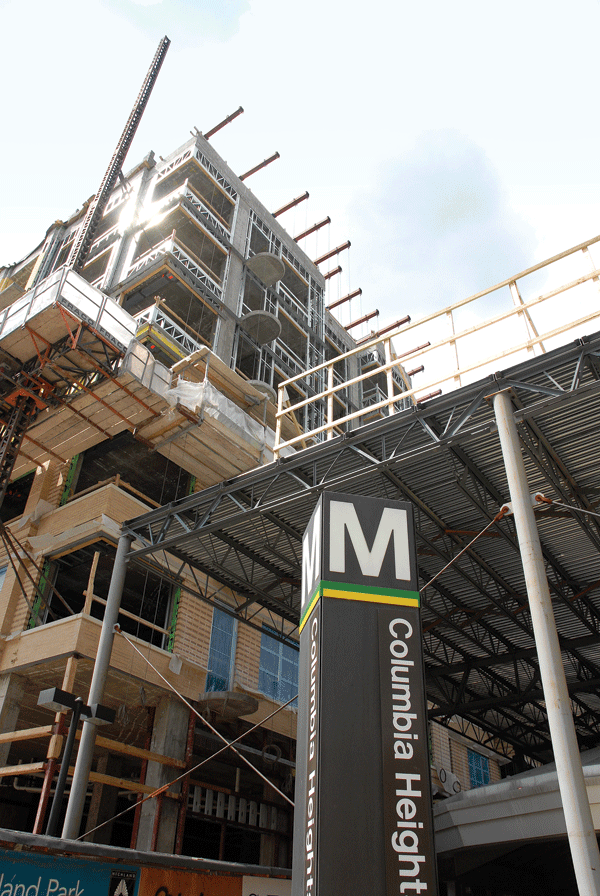 the region needs will require an unequivocal commitment of additional resources from internal and external stakeholders. Simply put, the rehabilitation work being accomplished at the time of the writing of this document will not be nearly enough to keep up with the region’s needs, and without additional resources it will be unlikely that the region can continue to enjoy a transit network that contributes to competitiveness and makes the Washington metropolitan area one of the most desirable places to live and work.
the region needs will require an unequivocal commitment of additional resources from internal and external stakeholders. Simply put, the rehabilitation work being accomplished at the time of the writing of this document will not be nearly enough to keep up with the region’s needs, and without additional resources it will be unlikely that the region can continue to enjoy a transit network that contributes to competitiveness and makes the Washington metropolitan area one of the most desirable places to live and work.
Metro – Doing Business Differently
Metro recognizes that rebuilding the region’s transit system also means rebuilding the region’s transit authority – and will continue to be hard at work on this task in preparation for the implementation of Momentum. In the near term this means revamping nuts and bolts elements of the authority, including but not limited to: identifying ways that Metro can do its job more efficiently while increasing performance; evaluating its contracting and procurement philosophy to emphasize lifecycle contract and asset management; engineering a budgeting process that allows Departments to strive to achieve the goals of Momentum within the context of tight fiscal and financial discipline; and a human capital strategy that must have the right talent in-place and in-queue. In the long term, this means completing the journey to a much more business-like operating and execution philosophy for the organization.
A next generation communications 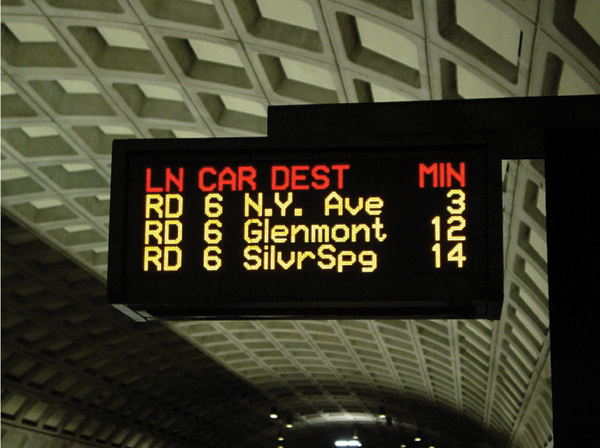 system would expand current communications infrastructure to provide an integrated one-stop communications hub for the region’s transit customers. Proposed improvements will capitalize on efforts already underway to improve the functionality of the rail control software. They include the next generation of the Passenger Information Display System (PIDS), new public address systems, improved station signage, and equipping station managers with mobile devices. Bus and train information will also be integrated, with real-time information displays to well-used bus stops.
system would expand current communications infrastructure to provide an integrated one-stop communications hub for the region’s transit customers. Proposed improvements will capitalize on efforts already underway to improve the functionality of the rail control software. They include the next generation of the Passenger Information Display System (PIDS), new public address systems, improved station signage, and equipping station managers with mobile devices. Bus and train information will also be integrated, with real-time information displays to well-used bus stops.
Read more…



 )
)







Recent Comments